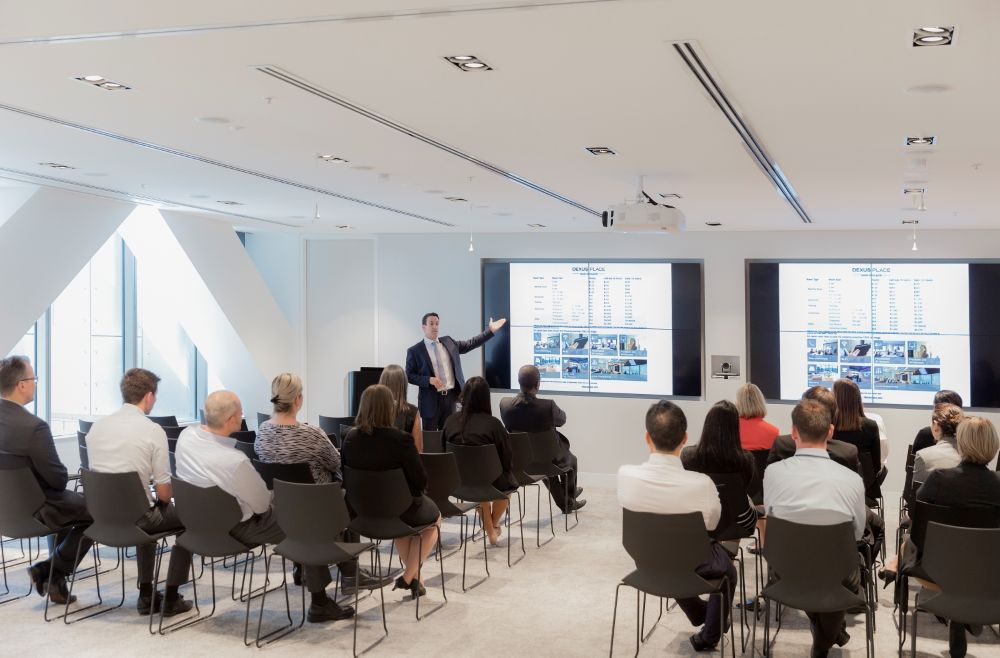The common pain point in Australian workplaces often centres on one thing: too many ineffective, time-consuming meetings. Hours are wasted, decisions are stalled, and momentum is lost. Introducing effective meeting facilitation is the key solution to transforming this chronic problem into a powerful driver of productivity.
This guide will provide essential meeting facilitation best practices. The objective is to help your teams run efficient, outcome-driven sessions, whether you are preparing for agile meetings or standard weekly huddles.
Why is Effective Facilitation Important?
Strong meeting facilitation is a skill that elevates your entire organisation. It moves beyond simply managing time; it ensures the conversation is structured, inclusive, and firmly focused on actionable outcomes, empowering your teams to hold a productive team meeting.
A well-run session is one where every participant feels heard, and concrete next steps are clearly defined before anyone leaves the room. Poorly facilitated meetings, in contrast, are notorious for allowing discussions to drift without any clear purpose or measurable result.
Facilitation transforms a chaotic discussion into a structured decision-making engine.
Best Practices for Facilitating Effective Meetings
After the initial preparation, the session itself requires practical techniques for active management. Facilitating effective meetings means managing the process, not the people, ensuring maximum output from the time invested.
1. Start Strong: Define Purpose, Outcomes, and Roles
Before sending out your calendar invite, you must clearly define the "why" and "what" of your meeting. Best practices dictate that the very first thing you do is state the session's purpose and the required outcomes—whether you need concrete decisions, assigned action items, or consensus.
Don't stop there: assign a clear owner (the facilitator) and a dedicated note-taker. This division of labour ensures you can focus entirely on managing the discussion flow, knowing accountability is locked in from the first minute.
2. Remember: It’s Not About You, It’s About the Work
Your primary job as a facilitator is to serve the meeting's purpose, not to dominate the discussion or present your own opinions. Facilitation best practices here involve mastering the skill of active listening. You must guide your teams towards consensus using neutral language and open questions. Always keep personal anecdotes or unnecessary presentations short; your goal is to maximise time for valuable group input.
Remember, the meeting belongs to the team's collective intelligence, not just your voice.
3. Recharge the Room: Integrate Intentional Breaks
If you are facilitating brainstorming meetings or complex discussions that run longer than an hour, breaks are highly beneficial. Cognitive science clearly shows that attention spans drop significantly without a pause. Schedule short, intentional breaks—for instance, 5–10 minutes every hour—to maintain energy and sharp focus.
Consider making a tactical move from the main conference room to a quick coffee station. Changing the physical setting actively refreshes participants' minds and prevents decision fatigue.
4. Stay on Track: Stick to the Agenda and Timeboxing
You are the timekeeper, and your control over the agenda is critical to success. You must enforce strict adherence to the pre-agreed time slots. To manage scope creep without shutting down good ideas, master the powerful technique of "parking lot" irrelevant ideas. Always use a visible timer, and gently nudge your teams forward when discussions become circular or overly focused on a single point.
5. Give Every Voice Space: Facilitate Inclusive Participation
As a skilled facilitator, you must actively ensure all voices are heard, particularly those who are quiet or remote. Inclusivity directly impacts the quality of your decisions, as you need input from every area of expertise. Try techniques like a "round-robin" method for gathering initial thoughts, or specifically calling on non-speakers, inviting them to contribute their knowledge.
You should make the meeting safe for introverts and deep thinkers by soliciting pre-reads or allowing written input via collaborative technology tools. This strategy ensures valuable insights are shared without forcing uncomfortable real-time verbal participation.
6. Bring the Visuals: Use Technology and Tools Effectively
You should leverage collaborative technology tools (such as digital whiteboards, shared documents, and polling software) to actively enhance engagement. These tools ensure everyone can contribute, regardless of where they are working from.
Visually documenting the conversation—capturing notes, ideas, and action items in real-time—is non-negotiable. This approach increases transparency and helps teams track decisions effectively and provides a clear record of outcomes after the meeting concludes.
What Not To Do When Facilitating a Meeting
Despite knowing the best practices, you can still trip up on common mistakes, misses, and faux pas. Understanding these pitfalls is vital, as they can quickly derail momentum and frustrate your teams. Your success hinges on proactively managing these risks.
Here are common pitfalls and mistakes you might be doing at your team meetings:
- No Clear Next Steps: Finishing a session without clear action items, designated owners, and fixed deadlines is a sure-fire way to waste everyone's time. The meeting lacks a tangible outcome.
- Your fix: Always end by summarising the "who, what, and when" for every task.
- Dominating a Discussion / Enabling Dominators: Never permit one or two individuals to monopolise the discussion, stifling the crucial input of others. Your teams lose valuable perspective, and quiet participants become disengaged.
- Your fix: Gently interrupt dominators and redirect the focus by inviting non-speakers to contribute their expertise.
- Ignoring Group Dynamics & Cultural Differences: Failing to recognise that different participants have varied communication styles and cultural norms can lead to misunderstandings and a lack of psychological safety.
- Your fix: Set clear communication guidelines at the start, ensuring everyone understands and respects diverse approaches to dialogue.
- Neglecting Participation: Allowing a few individuals to carry the conversation while others remain silent means the meeting fails to tap into the collective intelligence of the group, leading to weaker decisions.
- Your fix: Use techniques like "go-arounds" to solicit input from every person present.
- “Too Many Cooks” (Over-Inviting): Inviting too many people who are only peripherally relevant to the topic makes the meeting slow and expensive (in terms of collective salaries) and makes decision-making impossible.
- Your fix: Adopt the "two-pizza rule"—if you can't feed the team with two pizzas, you have too many attendees.
- Uncondusive Environment (The “Cramped Room”): Hosting a critical discussion in a cramped, distracting, or poorly equipped meeting room is a bad move. Physical discomfort, poor acoustics, and technological failures severely hinder focus and collaboration.
- Your fix: Always choose a space that is appropriately sized, technologically ready, and comfortable for the purpose of the meeting.
Post-Meeting: The Art of an Actionable Follow-Through
You've successfully managed the discussion and reached a decision. Now comes the crucial final phase of effective meeting facilitation. Follow-up is essential, as it ensures the valuable time spent by your teams results in tangible, measurable progress, transforming talk into action.
Actionable Follow-Up and Accountability
You must immediately distribute meeting summaries, key decisions, and assigned action items—clarifying the who, what, and when for every task. Circulating key outcomes immediately after the session reinforces accountability and prevents ambiguity about assigned tasks. Without this crucial step, even the best meeting is simply a good conversation that delivers no results.
Feedback Loops for Continuous Improvement
Learning how to continuously refine your approach is the hallmark of a professional. You should start gathering quick feedback on the meeting process itself—perhaps using a simple rating system or a short survey—from attendees. Using this feedback allows you to elevate your technique and ensures your future sessions are even more effective at facilitating effective meetings.
The Collaborative Edge

Mastering meeting facilitation is a core competency that directly drives better results and fosters innovation in Australian teams. You must remember that intentional structure and expert management, not simply clock-watching, are the keys to truly productive sessions.
Poorly equipped, distracting spaces are no longer acceptable. If you are looking for premium workspaces designed for high-quality outcomes, The Work Project offers premium coworking spaces with high-spec amenities, ensuring a professional setting every time. Book a meeting room in Sydney to experience productive, outcome-driven collaboration that delivers real results.






